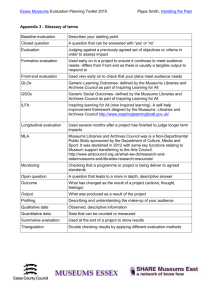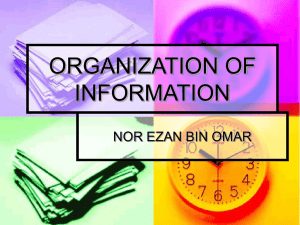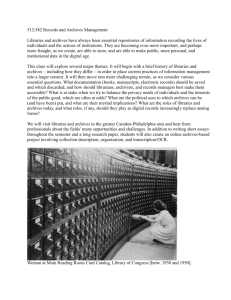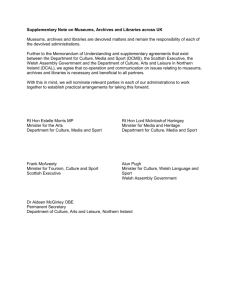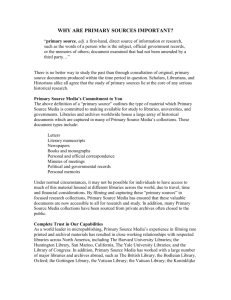(no.29) ( - 81kb)
advertisement
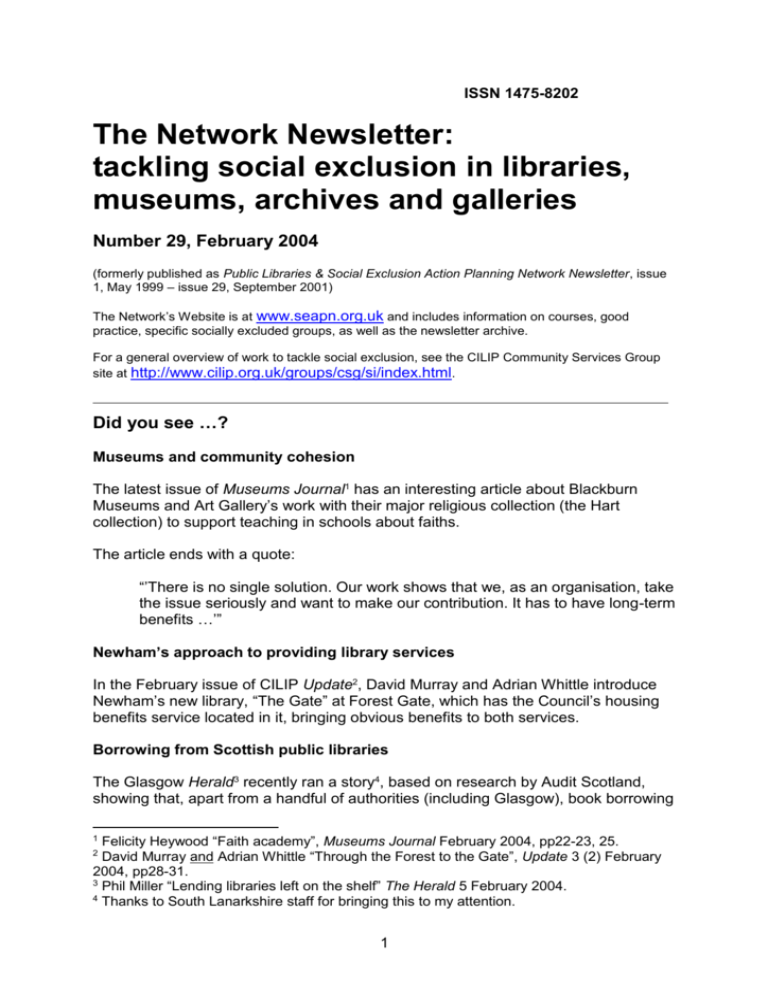
ISSN 1475-8202 The Network Newsletter: tackling social exclusion in libraries, museums, archives and galleries Number 29, February 2004 (formerly published as Public Libraries & Social Exclusion Action Planning Network Newsletter, issue 1, May 1999 – issue 29, September 2001) The Network’s Website is at www.seapn.org.uk and includes information on courses, good practice, specific socially excluded groups, as well as the newsletter archive. For a general overview of work to tackle social exclusion, see the CILIP Community Services Group site at http://www.cilip.org.uk/groups/csg/si/index.html. Did you see …? Museums and community cohesion The latest issue of Museums Journal1 has an interesting article about Blackburn Museums and Art Gallery’s work with their major religious collection (the Hart collection) to support teaching in schools about faiths. The article ends with a quote: “’There is no single solution. Our work shows that we, as an organisation, take the issue seriously and want to make our contribution. It has to have long-term benefits …’” Newham’s approach to providing library services In the February issue of CILIP Update2, David Murray and Adrian Whittle introduce Newham’s new library, “The Gate” at Forest Gate, which has the Council’s housing benefits service located in it, bringing obvious benefits to both services. Borrowing from Scottish public libraries The Glasgow Herald3 recently ran a story4, based on research by Audit Scotland, showing that, apart from a handful of authorities (including Glasgow), book borrowing Felicity Heywood “Faith academy”, Museums Journal February 2004, pp22-23, 25. David Murray and Adrian Whittle “Through the Forest to the Gate”, Update 3 (2) February 2004, pp28-31. 3 Phil Miller “Lending libraries left on the shelf” The Herald 5 February 2004. 4 Thanks to South Lanarkshire staff for bringing this to my attention. 1 2 1 was dropping. It also highlights the importance of libraries’ transformation – including providing training and computer access. There is a strong statement by Elaine Fulton, Director of the Scottish Library and Information Council, who is quoted as saying: “’At a time when the promotion of literacy is a major concern, it is difficult to see why councils continue to under-invest in their library service, when it has such potential to contribute to literacy development and foster the love of reading for life.’” Raising educational standards … The Local Government Association [LGA] has recently published a report5 setting out the role that cultural services can play in raising standards in schools and beyond. “Cultural services” are defined as the arts, libraries, archives, museums, historic environment, leisure, sport, recreation, parks and children’s play. The report argues a general case for the value of cultural services, and then looks at each area (as follows) with brief text and lots of case studies: Public libraries and lifelong learning (including libraries and learning, libraries developing basic skills, libraries and ICT (“tackling the digital divide”), and the changing face of libraries (Tower Hamlets’s Idea Stores and Sunderland’s Washington Millennium Centre) Archives, museums and galleries and lifelong learning (including archives and learning, archives recording and Black and ethnic minority history, museums and galleries and learning The arts’ contribution to lifelong learning Sport and lifelong learning. The report also asks for further examples of good practice (I thought that the sections on the arts and sport could do with developing, and parks and children’s play are not really covered at all), and includes a summary of national initiatives and on-line services which can facilitate informal lifelong learning. Despite the fact that the report has “in schools” in its title, there really is not much mention of the work we do with and in schools, and, again, this is an area which could usefully be developed. However, this is a really useful summary of the role that we can play – and would also act as a helpful advocacy document for anyone who thinks we cannot contribute to this policy area. I also found the executive summary (p5-7) interesting, in that it spells out some of the background to this work: “In July 2002, the LGA and the government agreed a set of seven shared priorities on which it is most important to deliver tangible improvements over 5 Raising educational standards in schools and beyond: the contribution from cultural services. Local Government Association, 2003. (ISBN: 1-84049-349-6). Available free from the LGA, Local Government House, Smith Square, London SW1P 3HZ. Tel: 020 7664 3000; fax: 020 7664 3030; e-mail: info@lga.gov.uk. 2 the next three years. The priorities cover some of the most challenging areas of public policy: raising educational attainment; services for children and older people; improving the environment; promoting economic vitality; improving health; improving public transport; and reducing crime.” Whilst I knew that these were Government priorities, I hadn’t seen anywhere prior to this that the LGA had committed local authorities to delivering on these. People with learning disabilities The DOH has recently developed a Learning Disabilities Website which gathers together a lot of useful, current information – available at www.doh.gov.uk/learningdisabilities. Travellers Birmingham Library & Information Service have recently published a new book about Birmingham and Midlands Travellers6. Details are: Ted Rudge Brumroamin – Birmingham and Midland Romany Gypsy and Traveller culture. Birmingham Library and Information Service, 2003. £11.957 Languages and countries of origin Anne Brimlow, Essex Libraries’ Manager: Access and Social Inclusion, has sent me details of a Website that contains information on languages and their countries of origin, which is at www.ethnologue.com. Anne also adds “At the same time, we discovered there are at least 159 different languages spoken by pupils in Essex schools and their families. That’s risen from 115 in last year’s count.” Somali refugees in London 6 Thanks to John Pateman for bringing this to my attention. Available from Birmingham libraries and bookshops, or by mail order from Marje Westley, Bookings and Sales, Birmingham Central Library, Chamberlain Square, Birmingham B3 3HQ – cheques payable to “Birmingham City Council”. Credit cards accepted. 7 3 Tony Olden (Thames Valley University) has kindly sent me a copy of an article8 he wrote, which gives a valuable insight into the background to the arrival of Somali refugees in the UK, and also looks at their cultural, library and information needs, and points the way to further research that is required. Mapping the territory The National Literacy Trust has published, on behalf of the Museums, Libraries and Archives Council, this study9 of the role of libraries, archives and museums in contributing to the Government’s Basic Skills targets, set out in Skills for life10. The report sets out baseline information on these activities, and gives examples of the wide variety of approaches that have been developed. Key findings include that: 84% of responding, museums, libraries and archives have some type of outreach or promotion to help reach adults with basic skills needs 75% of respondents thought that museums, libraries and archives should support adult basic skills 68% of respondents are engaged in partnerships which aim to improve adult basic skills 78% use technology to improve access for adults with basic skills needs. The journey to race equality This new report11 from the Audit Commission is very timely. It starts by looking at the reasons why race equality matters to the public sector, and then goes on to look at what race equality means. It asks “What does ‘race equality’ look like?”, and suggests reasons why public sector staff and Black and ethnic minority people are reluctant to speak out about it, giving some useful examples of local perceptions of discrimination and race inequality. It then looks at what Black and ethnic minority people actually experience (eg racial discrimination and stereotyping); asks what Black and ethnic minority communities expect from public services; and then focuses on “Outcomes to improve the quality of life”, and suggests what local outcomes there could be: Influence in decision-making Anthony Olden “Somali refugees in London: oral culture in a Western information environment”, Libri 1999, vol.49, pp 212-224. 9 Mapping the territory: a baseline study of the ability of museums, archives and libraries to contribute to the Government’s targets for adult basic skills in England. National Literacy Trust, 2003. Available at www.literacytrust.org.uk/mapping. 10 Skills for life: the national strategy for improving adult literacy and numeracy skills. DfEE, 2000. 11 The journey to race equality: delivering improved services to local communities. Audit Commission, 2004. £15.00 (ISBN: 1-86240-477-1). 8 4 Accessible services and information Employment Community-wide trust and confidence Positive community relations Service outcomes. These are illustrated with a handful of case studies (eg Improving health outcomes for African Caribbean people in Bristol). In section 2, the report looks at how the public sector is responding. It says that “Public services are also confident about their progress. Four in five believe they have made good progress with implementing their race equality scheme.” (p17) However, the report indicates that “a gap between optimism and reality is emerging” (p17) and that “Confidence is not universal” (p18). It sets out a table to show the 5 different levels at which organisations may be operating: Resisting Intending Starting Developing Achieving. and suggests that organisations must quickly improve by working through these stages. In section 3, the report looks at the common barriers to progress (the most commonly cited being lack of funding or resources), and then provides advice about tackling some of these issues head-on – the paragraphs on “Confusion about mainstreaming” (p25), “Lack of resources” (pp25-26), and “Too many or too few targets” (p27) are particularly helpful. In section 4, the report looks at race equality and managing change, and identifies the key factors in successful change management (leadership; culture and rationale; vision, priorities and outcome; engaging local Black and minority ethnic communities; capacity; working with others; managing performance), and again illustrates these with case studies. Section 5 looks at encouraging and sustaining progress. Finally, the report has a table, “What next for race equality?”, which pulls together the key issues into 5 areas: Understand why race equality matters Create a clear vision Make progress Develop the business case Encourage local ownership. 5 For each, it outlines: action for local agencies; action for national agencies; and action for regulators. This is a very readable and helpful report that should assist public organisations to make progress quickly. Home from home Home from home12 is a superb resource pack aimed at those who are working to support the education and well-being of refugee children. The pack is divided into 4 sections, each of which includes: Introduction and overview Discussion of key issues Advice and guidance Practical strategies and suggested activities Further information on related resources and organisations. The four sections are: Welcoming and including refugee children and families Developing play opportunities Involving refugee parents Providing advice and support to parents. The pack is full of valuable information, such as a languages/countries of origin list, suggested activities, and masses of suggestions of Web resources. Sadly, as far as I can see, there is no mention of the role of libraries, archives or museums – we must make sure our role is more clearly recognised. An invaluable resource, highly recommended. This Newsletter was compiled by John Vincent, and all items are written by him, unless otherwise stated. Please send any comments or items for the next issue to: John Vincent Wisteria Cottage Nadderwater Exeter EX4 2JQ Tel/fax: 0845 128 4897 E-mail: john@nadder.org.uk February 2004 12 Home from home: a guidance and resource pack for the welcome and inclusion of refugee children and families in school. Salusbury WORLD and Save the Children, 2004. £18.95 (ISBN: 1-84187-083-8). 6
